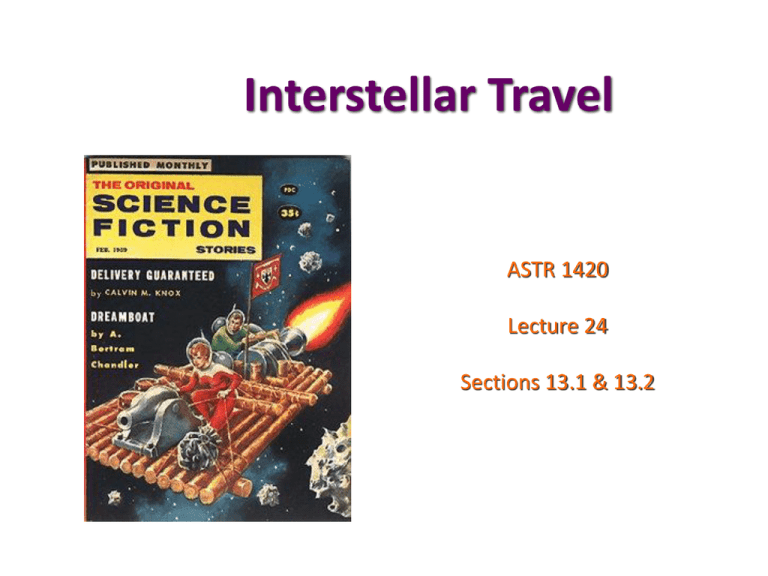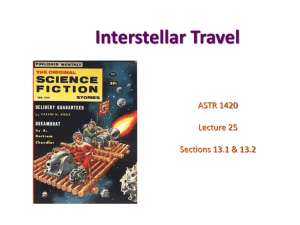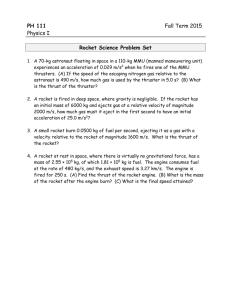Lecture24_Travel
advertisement

Interstellar Travel ASTR 1420 Lecture 24 Sections 13.1 & 13.2 Four spacecrafts flying away from the Sun Pioneer 10 • Launched on March 1972 (moving away from the Sun at 12.2 km/sec) now at ~28 light minutes away! Scenes from Earth will take ~120,000 years to the nearest star (if it were aimed directly at it). Rockets = Newton’s 3rd Law • For every action, there is an equal and opposite re-action! Engine (and rocket) being pushed forward Exhaust Flow pushed backward Tyranny of Distance the largest rocket ever built (Saturn V; used in the Apollo mission) ?? If we build a larger version of this rocket, can our descendants travel among the stars? No! Chemical Rockets are limited by Mass ratio • Need to accelerate fuel also! Mass ratio o mass ratio = weight of a rocket with fuel / without Current technology o To escape from Earth: mass ratio = 39 o Best single-stage rocket: mass ratio < 15 • Multi-staged rockets o Necessary, and used, to leave Earth, or even for intercontinental ballistic missiles o Interstellar travel: impractical, hundreds to thousands of stages required Even with the most powerful hypothetical rocket engine with 100 stages achieve 0.001c takes 4,000 yrs to the nearest star! Space Elevator Can reduce (by x100) the cost of sending material to space! • SpaceElevator Competition ($1M USD) How about different types of rockets? Nuclear Rockets Nuclear Thermal Rocket Engine o Advantage: higher energy/mass ratio of nuclear reactions o Disadvantage: difficult controlled use, especially fusion o Maximum speed: ~ 0.1c, Dec 1, 1967 • Project Rover (1955-1972) o Fission rocket o Achieved speeds 23 times those of chemical rockets o Application: manned mission to Mars, since abandoned 1st ground experimental nuclear rocket engine Project Orion • Explode H bombs behind the spaceship and let the shock waves propel the spaceship • Too expensive, also violates “ban on nuclear explosions in space” Project Daedalus UK plan to reach Barnard’s star (5.9 Lyrs away) Construction in the Earth orbit Use pellets of 2H and 3He, ignited by an electron beam from the spacecraft Ion Engine • • • • Using heavy noble gas (e.g., Xe, Ar, etc.) as fuel gas. Ionize them by shooting electrons on them Ions are accelerated by specially designed electric acceleration grid. accumulated electrons are dumped outside. Ion Engine • • • • Continuous firing…but weak thrust! Need to be free from other ions… In vacuum. Much more efficient! Already used by NASA (1998, Deep Space 1) and ESA (2004, SMART-1, lunar orbiter). Picture of the Deep Space 1’s ion engine. weak thrust but continuous firing for long, long time! Solar Sailing Solar wind only reaches 0.003c, need to use sunlight decreasing sunlight with distance causes a challenge. Planetary Society - Cosmos 1 June 21, 2005, launched on Volna rocket from a Russian submarine. Failed to reach orbit. privately funded project. Solar Sail feasible? • 10-ton payload, sail 1000 km x 1000 km in size maximum speed is then only 0.04 c. • It would take roughly 75 years to get the nearest star (3 Ly away; ignoring deceleration & stopping) • Oops! The SAIL ALSO has mass! • A 1000 km x 1000 km. A gold leaf sail 1 atom thick (a real sail would have to be much thicker) would have a mass of 170 tons (it effectively becomes the payload), and so the top speed is 0.009 c. Now it takes over 300 years to get anywhere! • Continuous powering up the sail from Earth by using a focused laser is too expensive. Return trip? How to stop? Interstellar Ramjets • Accelerating fuel is a problem. Then, what about collecting fuel on the way? • Ramjets o Collect Hydrogen from the interstellar medium and fuse it (magnetic funnel for fuel collector). o Need a scoop that is hundreds of kilometer wide Spaceship the size of worlds Antimatter rocket (hypothetical) • Antimatter o Exists: all matter has antimatter o Matterantimatter annihilation: all mass released as rays (100% efficiency!) (E=mc2 , only <0.7% of mass change to E in nuclear reactions) o Problem: controlled storage • Edward Purcell : Imaginary antimatter rocketship with 100% engine efficiency… o maximum speed of 0.99c but still requires 14 time more mass in fuel than the payload. o if we want to stop at the designation 14 times more fuel to stop 14×14 = 196 times more fuel o for a round trip at 0.99c speed 196x196 more fuel ~40,000 than the mass of the payload!! Even with a hypothetical antimatter rocket, interstellar travel is very difficult! Speed Limit • Einstein’s special theory of relativity: For anything with a mass impossible to travel faster than the speed of light • Even at the speed of light, the nearest star is α Centauri at 4.4 light-years away. fastest round trip takes still 8.8 years! trip across the Galaxy takes 100,000 years! • Could it be that Einstein’s theory is wrong and that we will someday find a way to break the cosmic speed limit? Highly Unlikely! possible that a more comprehensive theory in the future may replace Einstein’s relativity theory, but such one will be inclusive of many verified results including the speed of light barrier. Travel Time at high speed • Time dilation time is different for highspeed travelers than for people stay at home time runs slower at high speed! Tship TEarth v 2 1 c HAZARD of interstellar flight • A spacecraft traveling at 0.1c hit by an 1-mm grain (mass of 0.012 grams) Same energy as a 1-ton object hitting at Mach9.5 (7,000 mi/hr)!! Unless there is a way to screen out all interstellar dust, the spacecraft will be easily destroyed! Additional Energy requirement!! imaginary spaceship with a plasma shield Interstellar Arks OK, fast traveling is challenging. How about slow traveling over long time? • Hibernation o How do we put people to sleep? hibernation gene? o How do we wake them up? • Long life: o Pure speculation o Robotic mission would be simpler • Multi-generational: o Perseverance in the mission and/or infighting o Loss of expertise Human hibernation?? • A Swedish man, Peter Skyllberg age 44, survived in a snow-trapped car for 2 months! • Experts believe that he might have been in a kind of human hibernation. Feb, 2012 2 months at -30°C Simulated long-term space journey • Nov 11, 2011 -- Six members of Russian Mars500 simulator stepping out of the windowless capsule after 520 days. • simulated the confinement, stress, weightlessness, and fatigue of interplanetary travel. • long confinement put the team members under stress as they grew increasingly tired of each other's company. Energy use of an Interstellar Ark • Velocity for interstellar travel o Escape velocity from Earth: 11 km/s o Travel velocity, say 0.001c = 300 km/s, dominates energy requirement • Kinetic energy o o o o o Mass: say 108 kg (105 ton) for 5,000 people = 9 x 1018 Joules = 2.5 x 1012 kW hr 1% of the world annual energy consumption 250 billion dollars (@ $0.10/kW hr) 1/5 of US GDP o Add cost of provisions, energy efficiency, deceleration! Hyperspace and Wormholes • Hyperspace o General theory of relativity (1916): space is warped by gravity • Wormholes o o o o o Rotating black holes connect to another flat space Other flat space may connect to ours somewhere, but may be not We will know only after we go through the wormhole Stellar black holes: have too strong a tidal force, which would rip us apart Massive black holes: only known in galactic nuclei, have to get there In summary… Important Concepts Important Terms • Need to accelerate fuel also • Advantage of in-orbit launch • Various rocket types and their pros and cons • Speed limit and time dilation • Difficulties of high speed space travel • Difficulties of low speed space travel • Mass ratio Chapter/sections covered in this lecture : 13.1 & 13.2 Terra-forming and Colonization : next class!






